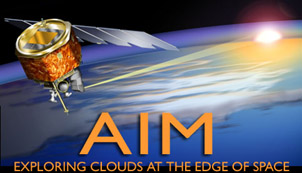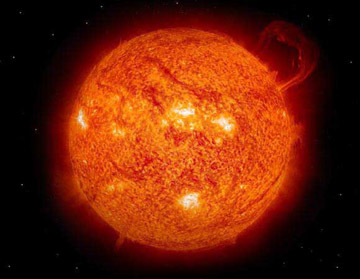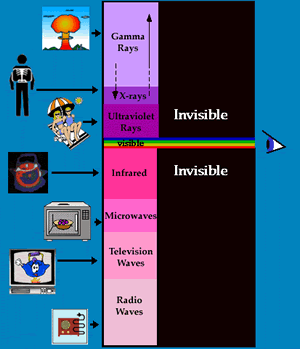Diagram of the electromagnetic spectrum
Click on image for full size
Windows to the Universe
The Electromagnetic Spectrum: All Sorts of Light!
There are many different types of energy that come from the Sun. All of the types of energy are part of the electromagnetic spectrum. The spectrum usually is divided into these seven parts:
Radio waves
These waves are used to bring you the tunes from your favorite radio station, but they are also a type of radiation from the Sun.
Microwaves
Microwaves can be used to study the Universe, communicate with satellites, and cook popcorn.
Infrared radiation
Instruments on satellites that detect plants, rock types, and characteristics of the atmosphere use infrared radiation.
Visible radiation
This is the part of the electromagnetic spectrum that humans are able to see. It includes all of the colors of the rainbow which, when combined, make white light.
Ultraviolet radiation
Ultraviolet radiation (UV) from the Sun is blocked by Earth's atmosphere, but some makes it through. UV radiation helps plants grow and humans make vitamin D in their bodies. However, too much UV can cause sunburns, skin cancer, cataracts, and can damage plants too.
X-ray radiation
X-rays travel through skin, tissue and organs but bounce off hard bone. That's how doctors use them to take photographs of bones.
Gamma-ray radiation
Gamma rays have the highest energy of all types of radiation!
Last modified July 9, 2004 by Lisa Gardiner.
You might also be interested in:

Leaders from the countries of the world are heading to Copenhagen, Denmark in December 2009 to decide how the world will deal with climate change. They will make decisions about how to send less greenhouse
...more
How do you know to pack your bathing suit and sunhat for a trip to a tropical island or pack warm sweaters and coats for a trip to Alaska? If you know a little about regional climates, then you know what
...more
Only a tiny amount of the gases in Earth’s atmosphere are greenhouse gases. But they have a huge effect on climate. There are several different types of greenhouse gases, but they all have something in
...more
Some satellites study Earth from space. Some of them study our atmosphere and weather. Some take pictures of clouds. Others use special instruments to make measurements of temperature, humidity, or the
...more
To figure out what the Earth might be like in the future, scientists need to know how Earth reacts to changes. Models help scientists to better understand how the Earth works and how it will react to climate
...more
Have you ever taken your temperature to see if you are getting sick? Scientists have been taking the Earth's temperature and have found that it is getting warmer. During the past 100 years, the Earth's
...more
The Sun Climate can change if there is a change in the amount of solar energy that gets to Earth. A change in the solar cycle can impact climate. The effect is too small to be the reason that global warming
...more















